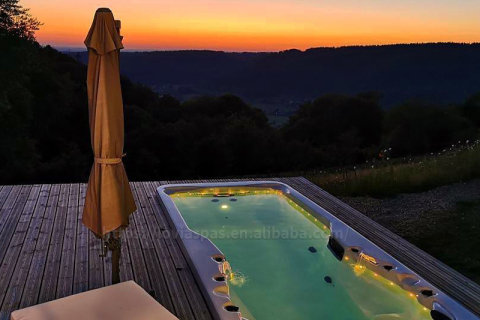
- Home
- >
News
In outdoor hot tub systems, ozone generators are a very important water treatment equipment that can effectively improve water quality and reduce the use of chemicals.
Generally speaking, the service life of hot tub ozone generators on the market is between 2 and 5 years. Some high-end models of ozone generators can even continue to work for more than 7 years, but this depends on the maintenance of the equipment.
The heating system in a hot tub is controllable, meaning that the user can turn it off as needed. On hot summer days, it is perfectly acceptable to turn off the heating system and keep the water in the tub at natural ambient temperature.
It needs to be made clear that bromine itself does not directly increase the pH value. The pH value is an indicator of the acidity and alkalinity of water, and the addition and normal use of bromine will not significantly change the pH value of water. However, when bromine is excessive, other indirect factors may affect the water quality and cause the pH value to fluctuate.
Water quality is one of the most important concerns for any hot tub user. The water in a hot tub must be clean and chemically balanced to provide users with a healthy soaking environment. If the water is not drained for a long time, water quality issues will be the first negative impact.
Generally speaking, the water temperature should be kept between 37-40°C (about 98-104°F), which is a range suitable for sterilization. Although it may not be a very high temperature, it helps to inhibit the growth of common bacteria and algae, thereby keeping the water clean.
Electric heaters are one of the most common types of hot tub heaters. They heat the water through a resistance element, are simple to install, and are widely used. Electric heaters usually cost between $500 and $1,500, depending on the power, brand, and heating efficiency. High-powered electric heaters heat water faster, but they also mean higher electricity costs.
For example, if a 2-horsepower pump (about 1,500 watts) runs for 1 hour, it consumes 1.5 kWh. If you use the massage jets for 1 hour per day, such a pump will consume about 45 kWh per month. The specific power consumption depends on the power of the pump and how long you use the massage function.
Alkalinity refers to the concentration of bicarbonate ions (HCO₃⁻) in water. Alkalinity not only affects the degree of pH fluctuation, but can also directly cause pH to rise. If the alkalinity in your outdoor hot tub is too high, the water's buffering capacity will increase, which will resist the drop in pH and cause the pH to gradually rise.
According to electrical installation standards, circuit breakers should be installed at a certain height from the ground, and the specific height varies according to electrical regulations in different countries and regions. Usually, this height ranges from 4 to 6 feet (about 1.2 to 1.8 meters).
The installation of an ozone generator in an outdoor hot tub is usually combined with a filtration system. When the water passes through the filtration system, the ozone generator injects ozone into the water flow, oxidizes pollutants and bacteria in the water, and then the clean water flows back into the bathtub.
When the alkalinity in a hot tub is too high, one of the most obvious consequences is the buildup of scale. Scale is a deposit formed by the reaction of minerals in the water, especially hardness components such as calcium and magnesium, with carbonates and bicarbonates.












